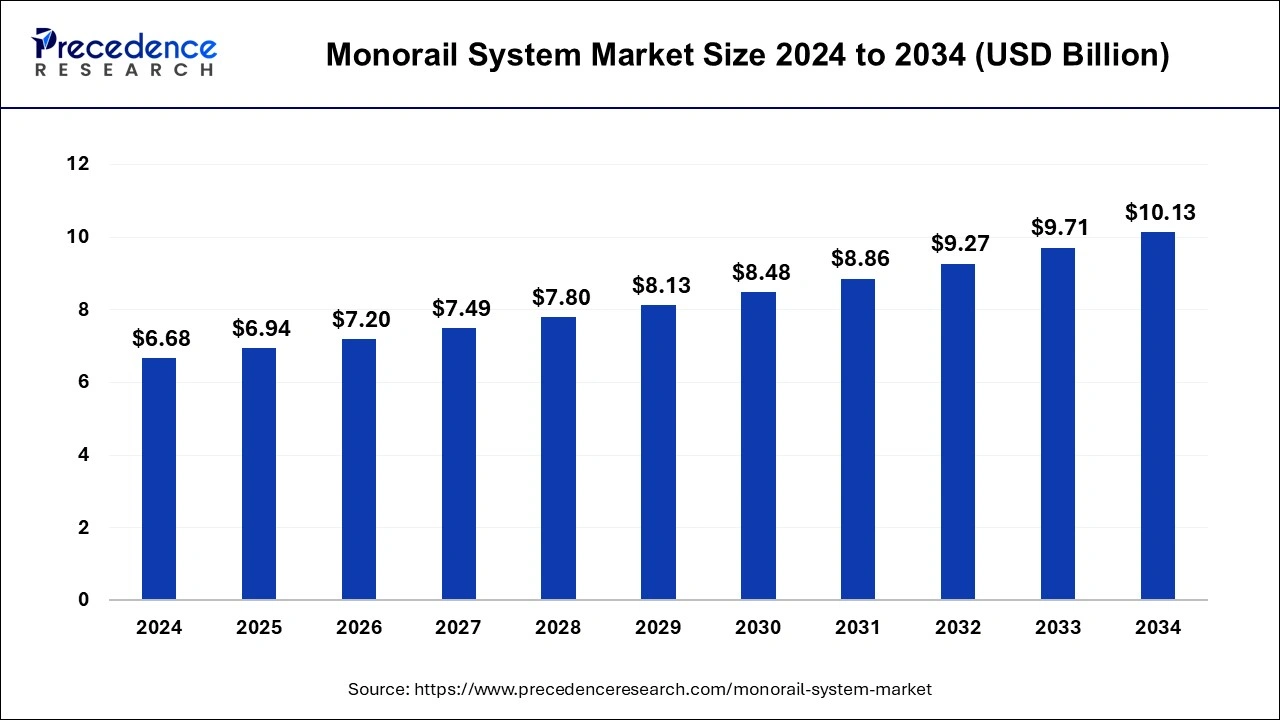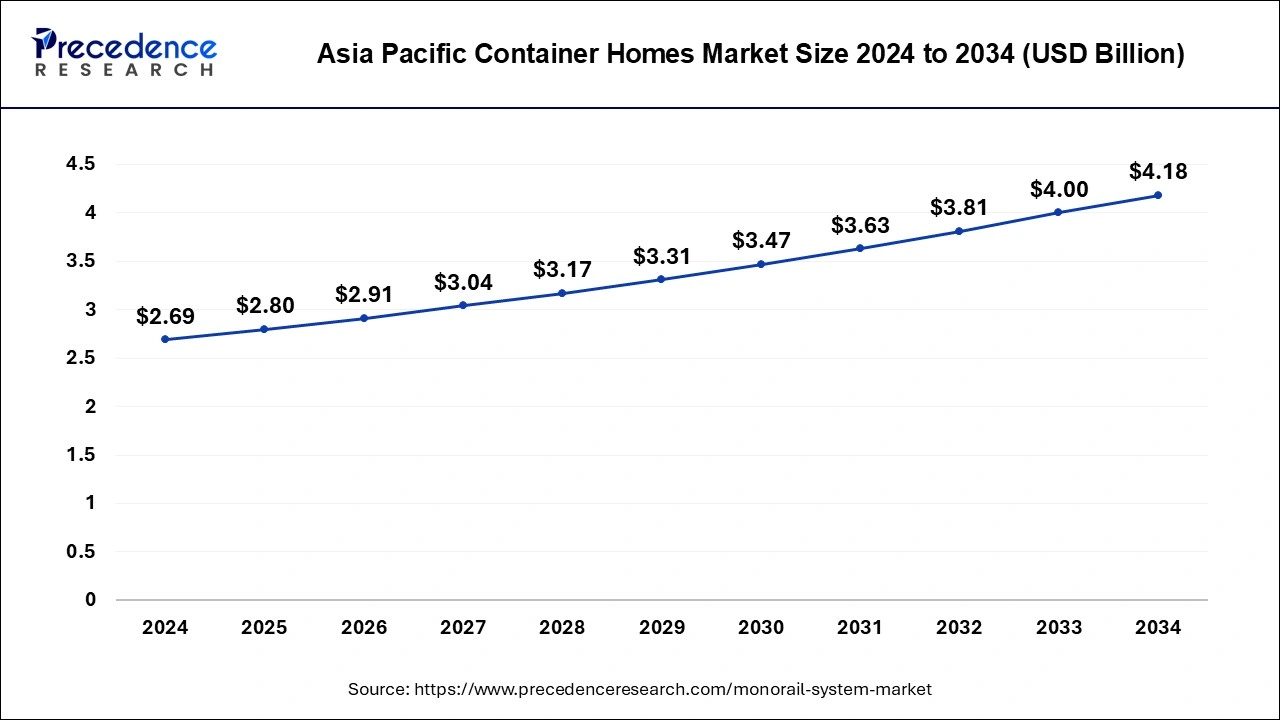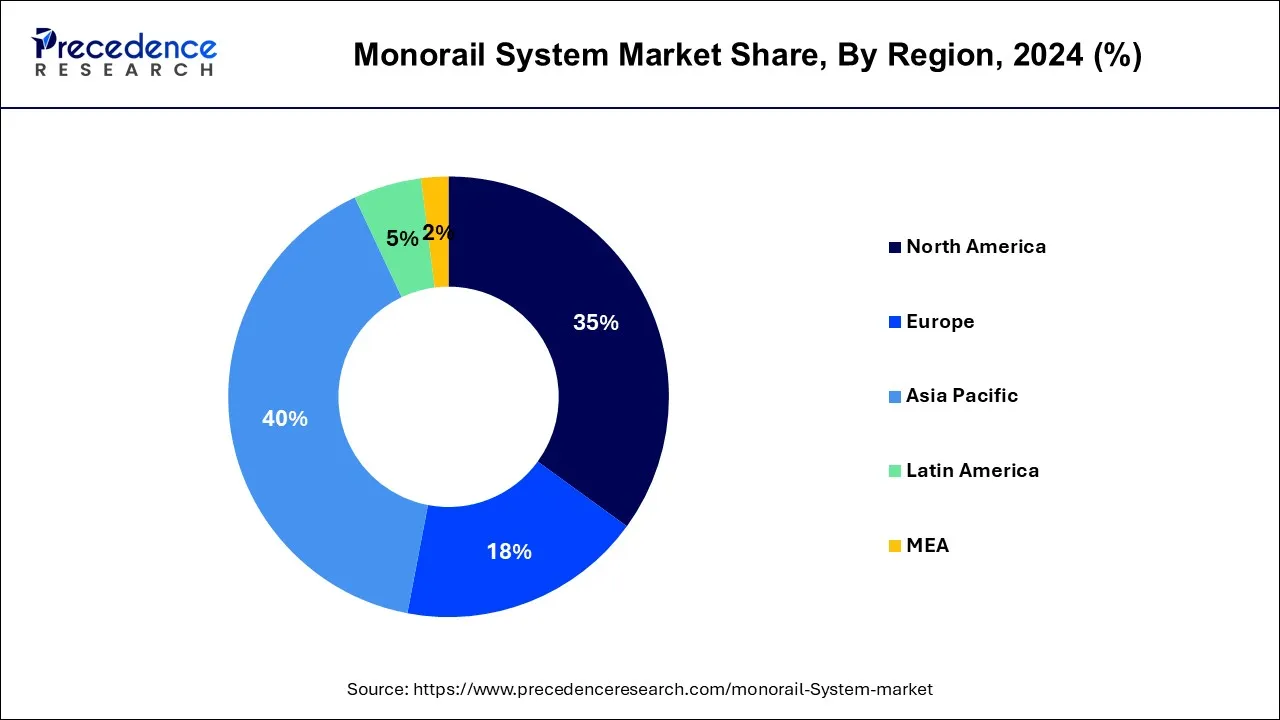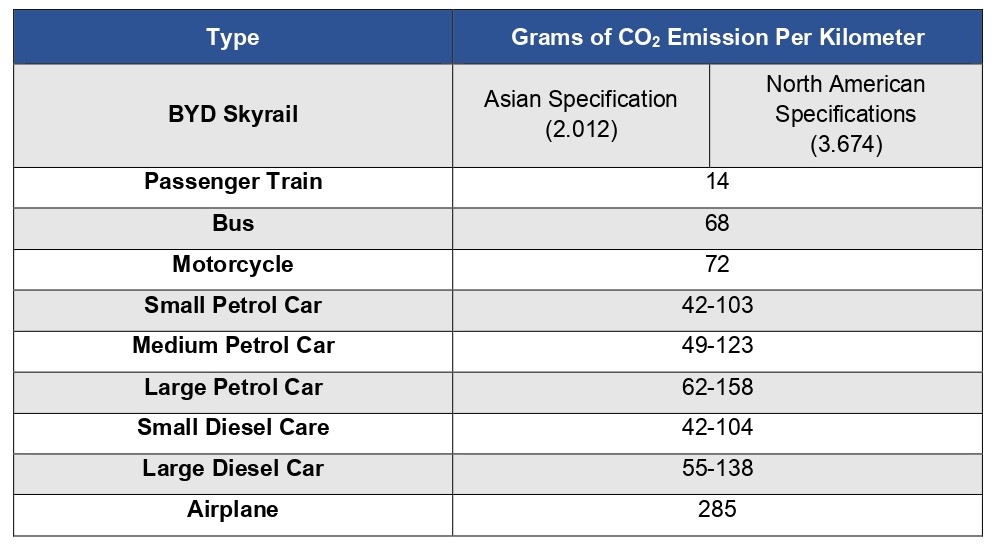September 2024
The global monorail system market size is calculated at USD 6.94 billion in 2025 and is forecasted to reach around USD 10.13 billion by 2034, accelerating at a CAGR of 4.25% from 2025 to 2034. The Asia Pacific monorail system market size surpassed USD 2.69 billion in 2024 and is expanding at a CAGR of 4.50% during the forecast period. The market sizing and forecasts are revenue-based (USD Million/Billion), with 2024 as the base year.
The global monorail system market size was accounted for USD 6.68 billion in 2024 and is anticipated to reach around USD 10.13 billion by 2034, growing at a CAGR of 4.25% from 2025 to 2034. The increasing demand for public transport, environmental sustainability, and increasing investments are the major growth factors of the monorail system market.

Artificial intelligence (AI) revolutionizes the railways and transportation systems driven by advanced features. AI and the Internet of Things (IoT) implement digitalization in railways and overcome several challenges conventional rail systems face. Integrating AI in monorail systems allows loco pilots to detect obstacles, recognize signals, and automate log analysis. These capabilities allow operators to take real-time corrective and maintenance action. AI-enabled predictive maintenance detects potential errors in monorails and mitigates operational issues, ensuring reliability. Thus, AI and IoT reduce operational costs while improving availability, allowing the rail industry to manage traffic volumes effectively. Moreover, AI can also examine track conditions, notify operators of any safety-affecting abnormalities, and avert potential derailments.
The Asia Pacific monorail system market size was exhibited at USD 2.69 billion in 2024 and is projected to be worth around USD 4.18 billion by 2034, growing at a CAGR of 4.50% from 2025 to 2034.

Asia Pacific contributed more than 40% of revenue share in 2024. Most of the under-construction projects are based in India, China, and ASEAN countries. In March 2019, India completed its first monorail project in Mumbai with an estimated investment of USD 5019 Mn on the project. In addition, rapid urbanization, rising traffic congestion, along with ever increasing population expected to propel the market growth in the region significantly.
Governments are preferring monorail systems due to rapid urbanization, an increase in the number of daily commuters, increased road traffic congestion, and the availability of tiny places. As a result of the enormous number of projected monorail system projects in Asia Pacific, the region is likely to provide profitable possibilities for monorail system manufacturers.

Rest of the world is another most opportunistic region that offers significant revenue growth in the coming years. The factors attributed to the market growth are increased per capita income, enhanced education quality, and the rising number of daily commuters are fueling the demand of monorail systems in the region.
North America is anticipated to grow at the fastest rate in the market during the forecast period. The rising adoption of monorail systems, technological advancements, and increasing investments drive the market. The increasing public-private partnership also supports market growth. The U.S. and Canadian governments collaborate with private organizations by providing funding and other necessary support in developing monorails for the country. As of September 2023, 16 monorail systems in use in the U.S. While, there are currently 6 monorail systems in Canada. The growing demand for public transport also contributes to the market growth. Approximately 6,800 organizations provide public transportation in the U.S. The increasing investments in modernizing public transportation infrastructure boosts market growth in North America.
Monorail is a type of elevated transportation system that is supported by a single track and is frequently referred to as a beam way. From airport transit to medium-capacity metros, monorail has a wide range of applications. Furthermore, companies now provide mass transit planners. Furthermore, the industry's growth is expected to be hampered by low market penetration, speed, and the availability of alternative options. Furthermore, over the forecast period, traffic congestion, technology advancements, and environmental compatibility are expected to provide profitable prospects for the market.
Monorails are capable of carrying only four to six cars at a time and sometimes up to eight cars. This is the prime factor why governments of several developing nations prefer rapid transit systems or metros over monorails. Nonetheless, its environment-friendly feature as it runs on electric and magnetic energy may make it a preferred choice for the intra-city transport system in the coming years.
| Report Highlights | Details |
| Market Size in 2025 | USD 6.94 Billion |
| Market Size by 2034 | USD 10.13 Billion |
| Growth Rate from 2025 to 2034 | CAGR of 4.25% |
| Largest Market | Asia Pacific |
| Base Year | 2024 |
| Forecast Period | 2025 to 2034 |
| Segments Covered | Type, Autonomy, Propulsion Type, Autonomous, Size, and Region |
| Regions Covered | North America, Europe, Asia-Pacific, Latin America and Middle East & Africa |
Surge in demand for electric monorails
Individually motorized carriers in electric monorail systems are powered by a track-mounted bus bar. Production areas or supply systems that require accumulation are typical applications. This system allows for a wide range of conveyor speeds, ranging from 8 to 400 fpm, permitting the carrier to fast-track, sneak into a meticulous location for automaticworkspaces, converse travel, travel on clear production hubs, travel at extremely high rates, accumulate, and so on. Furthermore, the electric monorail system can be equipped with an onboard computer that allows for decision-making for alternative routes without relying on the selected centralized conveyor system. Thus, the demand for electric monorail systems is driving the growth of the market.
Growing adoption of urban transportation
As urban areas across the globe expand and progress, the popularity of monorails as a cost-efficient, effective, and environmentally friendly transportation option is on the rise.
Also, the monorail has the lowest carbon footprint. Monorails cause fewer disruptions during construction and operation compared to other transportation alternatives.
Grams of CO2 Emissions Per Kilometer

They have a small footprint, requiring only 36 square feet for every 100 feet of elevated track, which reduces ground disturbance during and after construction. Furthermore, the monorail systems have the benefit of having the lowest operational and maintenance costs compared to other mass transit systems. Since monorail cars are elevated, they are less prone to vandalism and generally stay cleaner than ground-based rail systems. The important components like engines and guide rails have a longer lifespan than those in buses and trains, leading to lower long-term operating costs. Also, there are 42 urban monorail systems in operation across the globe, covering over 269 miles and serving more than 400 stations. These systems transport millions of passengers every day reliably.
Number of people transported per hour in an urban environment
| Car | Bus | Tram | Monorail | Metro |
| 2000 | 9000 | 22000 | 48000 | 50000+ |
High installation cost of maglev
The high installation cost of maglev compared to electric railway systems is one of the major constraints limiting its progress. In emerging markets, these cars have a low adoption rate. One of the greatest barriers to manufacturers joining the market, especially in developing and developed countries, is the increased installation costs.
Growing Utilization in Emerging Economies
The future of the monorail system market is promising, driven by the growing utilization of monorail systems in emerging economies. Developing countries like India, Saudi Arabia, Malaysia, Singapore, Thailand, etc. are actively installing monorail systems as part of their infrastructure projects. The government of such countries launches several infrastructure projects to improve the lifestyle of people. They also contribute by providing funding to accelerate the development and utilization of monorail systems. Some governments also emphasize domestic manufacturing, promoting a circular economy in a nation. The Indian Government allocated a budget of Rs 3 lakh crore for FY2025, an increase of 15-20% from the previous year.
Lack of innovation
In the monorail systems market, there is a dearth of innovation and research, and development. Companies must invest extensively in research and development to improve the capability of monorail systems, as well as their speed, reliability, and efficiency, in order to cut turnaround times. Thus, this is a major challenge for market growth.
Monorails are normally employed to support manufacturing undertakings. Straddle design of monorail system utilizes extremely effectual guideway design. The guideway's narrow beam is fashioned offsite in a way that route corridor can stay highly reachable to the general public during production. The accomplished guideway is considerably thinner and permits more light through compared to widespread bridge structures requisite by other transit vehicle designs, whereas employing suggestively fewer construction material. As a result, it has significantly lower construction costs.
Straddle type monorail led the global monorail system market in 2023 owing to its higher capacity of carrying passengers than suspended type. Thus, straddle type monorail are a preferred choice over for crowded and high-frequency transportation. However, suspended type is most used at zoos, parks, and other small areas where the number of passengers is less.
Straddle monorail, which uses rubber wheels and precast concrete track beams, is a unique urban rail transit system with great climbing capabilities, a small turning radius, minimal land use, low noise, moderate volume, and low cost.
In terms of autonomy, the completely autonomous segment held the major market share in 2023. The segment is experiencing growth due to its features, such as high reliability and safety, increased availability, short system delivery, seamless integration, and growing installation.
Electric monorails dominated the global monorail systems market in 2023. Electric monorails require less manufacturing time and cost as compared to maglev trains thus they captured most of the revenue share nearly 80% of the global market. In addition, Maglev trains are not suitable for short distance run such as intra-city transportation or within urban city travel as they have very high speed compared to electric monorails. Speed range of electric monorails is between 80 to 100 kilometers per hour on the other hand, maglev train speed is above 500 kilometers per hour. A rail-bound mode of transportation with separately operated vehicles that move independently on the rail system is known as an electric monorail. With the help of switch points, branch points can be implemented on a line.
The grade of automation is decided on the basis of a number of automated components in the train. Based on automation the global monorail system market is classified into GoA0, GoA1, GoA2, GoA3, and GoA4. GoA3 and GoA4 grade are considered as fully automated mass transport system and they possess highly level of punctuality and safety. They are mostly preferred in mass transits. However, GoA2 monorails are more preferred across the globe as they are more effective in reducing accidents along with enhancing the overall train performance. GoA2 trains are incorporated with Automatic Train Protection (ATP) and Automatic Train Operation (ATO) systems, and operated under surveillance. These are some of the important factors that drive the growth of the electric monorail systems market.
By Type
By Autonomy
By Propulsion Type
By Autonomous
By Geography
For inquiries regarding discounts, bulk purchases, or customization requests, please contact us at sales@precedenceresearch.com
No cookie-cutter, only authentic analysis – take the 1st step to become a Precedence Research client
September 2024
April 2025
April 2025
February 2025